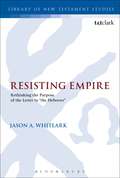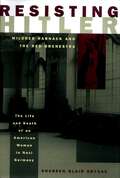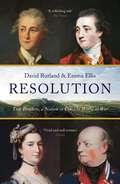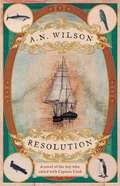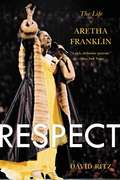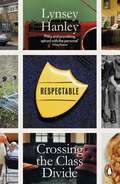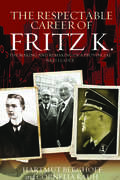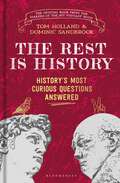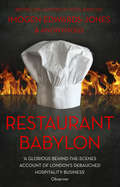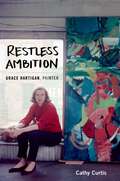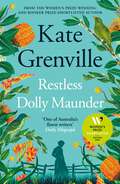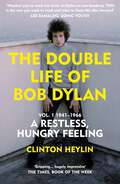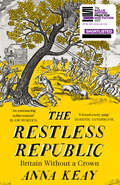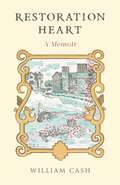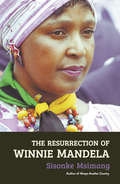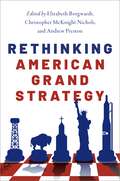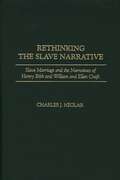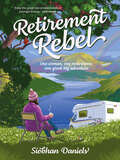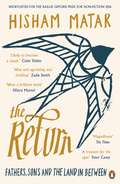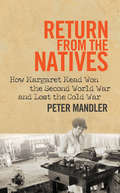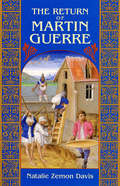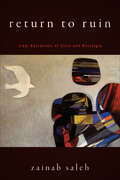- Table View
- List View
Resisting Empire: Rethinking the Purpose of the Letter to "the Hebrews" (The Library of New Testament Studies #484)
by Jason A. WhitlarkThis book offers a fresh reading about the purpose for which Hebrews was written. In this book Whitlark argues that Hebrews engages both the negative pressures (persecution) and positive attractions (honor/prosperity) of its audience's Roman imperial context. Consequently, the audience of Hebrews appears to be in danger of defecting to the pagan imperial context. Due to the imperial nature of these pressures, Hebrews obliquely critiques the imperial script according to the rhetorical expectations in the first-century Mediterranean world-namely, through the use of figured speech. This critique is the primary focus of Whitlark's project. Whitlark examines Hebrews's figured response to the imperial hopes boasted by Rome along with Rome's claim to eternal rule, to the power of life and death, and to be led by the true, victorious ruler. Whitlark also makes a case for discerning Hebrews's response to the challenges of Flavian triumph. Whitlark concludes his study by suggesting that Hebrews functions much like Revelation, that is, to resist the draw of the Christians' Roman imperial context. This is done, in part, by providing a covert opposition to Roman imperial discourse. He also offers evaluation of relapse theories for Hebrews, of Hebrews's place among early Christian martyrdom, and of the nature of the resistance that Hebrews promotes.
Resisting Hitler: Mildred Harnack and the Red Orchestra
by Shareen Blair BrysacThis gripping and heartbreaking narrative is the first full account of an American woman who gave her life in the struggle against the Nazi regime. As members of a key resistance group, Mildred Harnack and her husband, Arvid, assisted in the escape of German Jews and political dissidents, and for years provided vital economic and military intelligence to both Washington and Moscow. But in 1942, following a Soviet blunder, the Gestapo arrested, tortured, and tried some four score members of the Harnacks' group, which the Nazis dubbed the Red Orchestra. Mildred Fish-Harnack was guillotined in Berlin on February 16, 1943, on the personal instruction of Adolf Hitler--she was the only American woman to be executed as an underground conspirator during World War II. Yet as the war ended and the Cold War began, her courage, idealism, and self-sacrifice went largely unacknowledged in America and the democratic West, and were distorted and sanitized in the Communist East. Only now, with the opening of long-sealed archives from Germany, the KGB, the CIA, and the FBI, can the full story be told. In this superbly told life of an unjustly forgotten woman, Shareen Blair Brysac depicts the human side of a controversial resistance group that for too long has been portrayed as merely a Soviet espionage network.
Resisting Hitler: Mildred Harnack and the Red Orchestra
by Shareen Blair BrysacThis gripping and heartbreaking narrative is the first full account of an American woman who gave her life in the struggle against the Nazi regime. As members of a key resistance group, Mildred Harnack and her husband, Arvid, assisted in the escape of German Jews and political dissidents, and for years provided vital economic and military intelligence to both Washington and Moscow. But in 1942, following a Soviet blunder, the Gestapo arrested, tortured, and tried some four score members of the Harnacks' group, which the Nazis dubbed the Red Orchestra. Mildred Fish-Harnack was guillotined in Berlin on February 16, 1943, on the personal instruction of Adolf Hitler--she was the only American woman to be executed as an underground conspirator during World War II. Yet as the war ended and the Cold War began, her courage, idealism, and self-sacrifice went largely unacknowledged in America and the democratic West, and were distorted and sanitized in the Communist East. Only now, with the opening of long-sealed archives from Germany, the KGB, the CIA, and the FBI, can the full story be told. In this superbly told life of an unjustly forgotten woman, Shareen Blair Brysac depicts the human side of a controversial resistance group that for too long has been portrayed as merely a Soviet espionage network.
Resolution: Two Brothers. A Nation in Crisis. A World at War
by David Rutland Emma EllisJohn Manners, Marquis of Granby, famously led a cavalry charge during the Seven Years War in 1760, losing both hat and wig. A commander of skill and courage, he was cherished by his men and lauded by the British public as an authentic military hero. Granby predeceased his father, the 3rd Duke of Rutland, and never inherited his title, but left two sons whose contrasting fortunes and tragically short lives are the subject of this meticulously researched and richly illustrated book. Charles became 4th Duke in 1779, sought reconciliation with the American colonies and was Viceroy of Ireland; Robert embarked on a naval career, became flag captain of the Resolution and died of injuries sustained at the Battle of the Saintes. Based upon the detailed archives held at Belvoir Castle, Resolution is both an enthralling saga of two generations of the Manners family and a finely delineated portrait of aristocratic, political and naval life in mid-Georgian England.
Resolution: A novel of Captain Cook’s discovery to Australia, New Zealand and Hawaii, through the eyes of botanist George Forster.
by A. N. WilsonA. N. Wilson's powerful new novel explores the life and times of one of the greatest British explorers, Captain Cook, and the golden age of Britain's period of expansion and exploration.Wilson's protagonist, witness to Cook's brilliance and wisdom, is George Forster, who travelled with Cook as botanist on board the HMS Resolution, on Cook's second expedition to the southern hemisphere, and penned a famous account of the journey. Resolution moves back and forth across time, to depict Forster's time with Cook, and his extraordinary later life, which ended with his death in Paris, during the French Revolution.Wilson once again demonstrates his great powers as a master craftsman of the historical and the human in this richly evoked novel, which brings to life the real and the extraordinary, brilliantly drawing together a remarkable cast of characters in order to look at human endeavour, ingenuity and valour.
Respect: The Life of Aretha Franklin
by David RitzThe definitive biography of the Queen of Soul from acclaimed music writer David Ritz. Aretha Franklin began life as the golden daughter of a progressive and promiscuous Baptist preacher. Raised without her mother, she was a gospel prodigy who gave birth to two sons in her teens and left them and her native Detroit for New York, where she struggled to find her true voice. It was not until 1967, when a white Jewish producer insisted she return to her gospel-soul roots, that fame and fortune finally came via "Respect" and a rapidfire string of hits. She has evolved ever since, amidst personal tragedy, surprise Grammy performances, and career reinventions. Again and again, Aretha stubbornly finds a way to triumph over troubles, even as they continue to build. Her hold on the crown is tenacious, and in Respect, David Ritz gives us the definitive life of one of the greatest talents in all American culture.
Respectable: The Experience of Class
by Lynsey HanleySociety is often talked about as a ladder, which you can climb from bottom to top. The walls are less talked about. This book is about how people try to get over them, what it means if they do, and how class affects all of us.In autumn 1992, growing up on a vast Birmingham estate, the sixteen-year-old Lynsey Hanley went to sixth-form college. She knew that it would change her life but was entirely unprepared for the price she would have to pay: to leave behind her working-class world and become middle class.Class remains resolutely with us, as strongly present as it was fifty years ago. Entwined with it is the idea of aspiration, of social mobility, which received wisdom tells us is an unequivocally positive phenomenon for individuals and for society as a whole. Yet for the many millions who experience it, changing class is like emigrating from one side of the world to the other, a lonely, anxious, psychologically disruptive process of uprooting, which leaves people divided between the place they left and the place they have to inhabit in order to get on. In this empathic, wry and passionate exploration of class in Britain today, Lynsey Hanley looks at how people are kept apart, and keep themselves apart - and the costs involved in the journey from 'there' to 'here'.
The Respectable Career of Fritz K.: The Making and Remaking of a Provincial Nazi Leader (Studies in German History #18)
by Hartmut Berghoff Cornelia RauhEntrepreneur and Nazi functionary Fritz Kiehn lived through almost 100 years of German history, from the Bismarck era to the late Bonn Republic. A successful manufacturer, Kiehn joined the Nazi Party in 1930 and obtained a number of influential posts after 1933, making him one of the most powerful Nazi functionaries in southern Germany. These posts allowed him ample opportunity to profit from “Aryanizations” and state contracts. After 1945, he restored his reputation, was close to Adenauer's CDU during Germany's economic miracle, and was a respected and honored citizen in Trossingen. Kiehn's biography provides a key to understanding the political upheavals of the twentieth century, especially the workings of the corrupt Nazi system as well as the “coming to terms” with National Socialism in the Federal Republic.
The Rest is History: The official book from the makers of the hit podcast
by Goalhanger Podcasts Dr Tom Holland Dominic SandbrookMake room Herodotus, stand down Bede, pipe down Pepys – there's a new history book in town.From the chart-topping podcast The Rest is History, a whistle-stop tour through the past – from Alexander the Great to Tolkien, the Wars of the Roses to Watergate. The nation's favourite historians Tom Holland and Dominic Sandbrook take on the most curious moments in history, answering the questions we didn't even think to ask:- Did the Trojan War actually happen?- What was the most disastrous party in history?- Was Richard Nixon more like Caligula or Claudius?- How did a hair appointment almost blow Churchill's cover?- Why did the Nazis believe they were descended from Atlantis?Whether it is sending historical figures to Casa Amor in a series of Love Island, ranking history's most famous eunuchs and pigeons (including Winkie, the unsung hero of the Second World War), or debating the meaning of greatness, there is nothing too big or too small for Tom and Dominic to unpick.So run your Egyptian milk bath, strap up your best Spartan sandals, and prepare for a journey down the highways and byways of the human past. . .WATERSTONES' BEST BOOKS OF THE YEAR: HISTORY
Restaurant Babylon
by Imogen Edwards-JonesWhat makes a restaurant hot? Whose name do you need to drop to get a table? Why is one place booked solid for the next nine months while somewhere equally delicious is as empty and inhospitable as the Gobi desert?Welcome to the restaurant business, where the hours are punishing, the conditions are brutal and the Chef's Special has been languishing at the back of the fridge for the past three days.This is an industry plagued with obsessives. Why else do some chefs drive themselves crazy in pursuit of elusive Michelin stars, when in reality all they're doing is 'making someone else's tea'?Nothing is left to chance: the lighting, the temperature or even the cut of the salmon fillet. There's even a spot of psychology behind the menu. What do they want you to order? What makes them the most money? And why should you really hold back on those side dishes? In Restaurant Babylon, Imogen Edwards-Jones and her anonymous industry insider lift the lid on all the tricks of the food trade and what really makes this £90 billion a year industry tick. So please do sit down, pour yourself some heavily marked-up wine and make yourself comfortable (although we'll need that table back by 8.30 sharp).
Restless Ambition: Grace Hartigan, Painter
by Cathy CurtisThis first-ever biography of American painter Grace Hartigan traces her rise from virtually self-taught painter to art-world fame, her plunge into obscurity after leaving New York to marry a scientist in Baltimore, and her constant efforts to reinvent her style and subject matter. Along the way, there were multiple affairs, four troubled marriages, a long battle with alcoholism, and a chilly relationship with her only child. Attempting to channel her vague ambitions after an early marriage, Grace struggled to master the basics of drawing in night-school classes. She moved to New York in her early twenties and befriended Willem de Kooning, Jackson Pollock, and other artists who were pioneering Abstract Expressionism. Although praised for the coloristic brio of her abstract paintings, she began working figuratively, a move that was much criticized but ultimately vindicated when the Museum of Modern Art purchased her painting The Persian Jacket in 1953. By the mid-fifties, she freely combined abstract and representational elements. Grace-who signed her paintings "Hartigan"- was a full-fledged member of the "men's club" that was the 1950s art scene. Featured in Time, Newsweek, Life, and Look, she was the only woman in MoMA's groundbreaking 12 Americans exhibition in 1956, and the youngest artist-and again, only woman-in The New American Painting, which toured Europe in 1958-1959. Two years later she moved to Baltimore, where she became legendary for her signature tough-love counsel to her art school students. Grace continued to paint throughout her life, seeking-for better or worse-something truer and fiercer than beauty.
Restless Ambition: Grace Hartigan, Painter
by Cathy CurtisThis first-ever biography of American painter Grace Hartigan traces her rise from virtually self-taught painter to art-world fame, her plunge into obscurity after leaving New York to marry a scientist in Baltimore, and her constant efforts to reinvent her style and subject matter. Along the way, there were multiple affairs, four troubled marriages, a long battle with alcoholism, and a chilly relationship with her only child. Attempting to channel her vague ambitions after an early marriage, Grace struggled to master the basics of drawing in night-school classes. She moved to New York in her early twenties and befriended Willem de Kooning, Jackson Pollock, and other artists who were pioneering Abstract Expressionism. Although praised for the coloristic brio of her abstract paintings, she began working figuratively, a move that was much criticized but ultimately vindicated when the Museum of Modern Art purchased her painting The Persian Jacket in 1953. By the mid-fifties, she freely combined abstract and representational elements. Grace-who signed her paintings "Hartigan"- was a full-fledged member of the "men's club" that was the 1950s art scene. Featured in Time, Newsweek, Life, and Look, she was the only woman in MoMA's groundbreaking 12 Americans exhibition in 1956, and the youngest artist-and again, only woman-in The New American Painting, which toured Europe in 1958-1959. Two years later she moved to Baltimore, where she became legendary for her signature tough-love counsel to her art school students. Grace continued to paint throughout her life, seeking-for better or worse-something truer and fiercer than beauty.
Restless Dolly Maunder: Shortlisted for the Women’s Prize for Fiction 2024
by Kate GrenvilleSHORTLISTED FOR THE WOMEN'S PRIZE FOR FICTION 2024 A DAILY MAIL NOVEL OF THE YEAR 2023 LONGLISTED FOR BEST FICTION IN THE INDIE BOOK AWARDS AUSTRALIA 2024 Born into the sweat and drudgery of a New South Wales sheep farm at the end of the 19th century, Dolly Maunder is different to her siblings. She will not endure the small, servile existence of a wife. Dolly, bright, ambitious and stubborn, dreams of a different fate, of building something that she truly owns. She will do whatever it takes to be the woman she deserves to be. Even with a husband and children, Dolly pushes the boundaries of what is ‘proper’ and what a wife and mother ought to do, as war spreads across Europe and the rules are forever changed. But every life has its limits. What happens when Dolly’s wanderlust finally risks taking her too far?
A Restless Hungry Feeling: The Double Life of Bob Dylan Vol. 1: 1941-1966
by Clinton Heylin'The definitive, scrupulously researched biography of a life steeped in mystery' ObserverThe definitive biography of one contemporary culture's most iconic and mysterious figures - musical revolutionary, Nobel Prize-winner, chart-topping recording artistIn 2016 it was announced that Bob Dylan had sold his personal archive to the George Kaiser Foundation in Tulsa, Oklahoma, reportedly for $22 million. As the boxes started to arrive, the Foundation asked Clinton Heylin - author of the acclaimed Bob Dylan: Behind the Shades and 'perhaps the world's authority on all things Dylan' (Rolling Stone) - to assess the material they had been given. What he found in Tulsa - as well as what he gleaned from other papers he had recently been given access to by Sony and the Dylan office - so changed his understanding of the artist, especially of his creative process, that he became convinced that a whole new biography was needed. It turns out that much of what previous biographers - Dylan himself included - have said is wrong; often as not, a case of, Print the Legend.With fresh and revealing information on every page A Restless, Hungry Feeling tells the story of Dylan's meteoric rise to fame: his arrival in early 1961 in New York, where he is embraced by the folk scene; his elevation to spokesman of a generation whose protest songs provide the soundtrack for the burgeoning Civil Rights movement; his alleged betrayal when he 'goes electric' at Newport in 1965; his subsequent controversial world tour with a rock 'n' roll band; and the recording of his three undisputed electric masterpieces: Bringing it All Back Home, Highway 61 Revisited and Blonde on Blonde. At the peak of his fame in July 1966 he reportedly crashes his motorbike in Woodstock, upstate New York, and disappears from public view. When he re-emerges, he looks different, his voice sounds different, his songs are different. That other story will be told in Volume 2, to be published in autumn 2022.Clinton Heylin's meticulously researched, all-encompassing and consistently revelatory account of these fascinating early years is the closest we will ever get to a definitive life of an artist who has been the lodestar of popular culture for six decades.
The Restless Republic: Britain Without A Crown
by Anna Keay‘A dazzling achievement’ SUNDAY TIMES ‘An exceptional book about an exceptional time’ JOHN ADAMSON ‘Anna Keay has rescued a period of history which for many will have been uncharted territory … An imaginative triumph’ A.N. WILSON ‘Deft, confident, deeply learned and provocative’ RORY STEWART
Restoration Heart: A Memoir
by William Cash'I read most of it in one exciting sitting. It is brilliant, gripping and sad' Harry MountRestoration Heart is a story of love, double divorce and redemption. It is a biography of the heart, and of a house. When William Cash suffers a post-divorce, mid-life breakdown, aged 43, life seemed bleak - but things were about to change. Like William himself, his old Shropshire family house Upton Cressett was in as much in need of being rescued and 'fixed up' as its owner. As William embarks on re-building his life and ruin of a country house, he starts looking again for love. But money, patience and the likelihood of ever finding family happiness soon start to run out.Drawing on his haul of letters written to various wives, fiancées and girlfriends - all potential third wives - the book follows Cash's search for a chatelaine for Upton Cressett. Restoration Heart is a tempestuous, Gulliver-like voyage of the heart with a colourful cast of figures including Tom Wolfe, Jay McInerney, Margaret Thatcher, Elizabeth Hurley, David Hockney, Piers Morgan, an American singer legend cousin and, most dramatically, future prime minister Boris Johnson. Hilarious and poignant, this 'restore-a-wreck' memoir is an account of how an Englishman is rescued by love, architecture and beauty. The memoir also holds up a dark lens to the Bonfire of the Vanities generation that Cash was a member of at Cambridge.The story reveals how a broken man can become completely transformed - both emotionally and imaginatively - by a building and its surrounding landscape. During the four year refurbishment, the house's reclamation becomes inexorably linked with his own re-birth and salvation before he finally marries for the third time and gets to live in his family house. This is not a misery-memoir; it is an uplifting - albeit tempestuous - Gulliver-like biography of the heart with an ancient Elizabethan house as the writer's Arcadian safe house and source of salvation.
The Resurrection of Winnie Mandela: A Biography Of Survival
by Sisonke MsimangThe death of Winnie Madikizela Mandela on 2 April this year unleashed a hailstorm of opinion. On one side, her legacy was cast by the media and public in the shadow of her sanctified ex-husband. Winnie was history’s loser. She was damaged goods; Nelson Mandela was whole and pure.A younger generation, in particular women, took a different view and so a battle of ideas began that sought to reframe Winnie’s career and reclaim her identity as an extraordinary woman and fierce political activist.Sisonke Msimang, an acclaimed author and public commentator, wasted little time in jumping into the fray. And when the dust settled, what emerged is this short but razor-sharp book which reflects critically on the turbulent yet remarkable life of Winnie. Msimang situates her political career and legacy in the contemporary context, what she means today in social and political terms, by exploring different aspects of her iconic persona.The Resurrection of Winnie Mandela is an astute examination of one of South Africa’s most controversial political figures, of the rise and fall – and rise, again, – of a woman who not only battled the apartheid regime, but the patriarchal character of the struggle itself. In telling Winnie’s story, Msimang shows us that activism matters, and that the meaning of women’s lives can be reclaimed.
Rethinking American Grand Strategy
A wide-ranging rethinking of the many factors that comprise the making of American Grand Strategy. What is grand strategy? What does it aim to achieve? And what differentiates it from normal strategic thought--what, in other words, makes it "grand"? In answering these questions, most scholars have focused on diplomacy and warfare, so much so that "grand strategy" has become almost an equivalent of "military history." The traditional attention paid to military affairs is understandable, but in today's world it leaves out much else that could be considered political, and therefore strategic. It is in fact possible to consider, and even reach, a more capacious understanding of grand strategy, one that still includes the battlefield and the negotiating table while expanding beyond them. Just as contemporary world politics is driven by a wide range of non-military issues, the most thorough considerations of grand strategy must consider the bases of peace and security--including gender, race, the environment, and a wide range of cultural, social, political, and economic issues. Rethinking American Grand Strategy assembles a roster of leading historians to examine America's place in the world. Its innovative chapters re-examine familiar figures, such as John Quincy Adams, George Kennan, and Henry Kissinger, while also revealing the forgotten episodes and hidden voices of American grand strategy. They expand the scope of diplomatic and military history by placing the grand strategies of public health, race, gender, humanitarianism, and the law alongside military and diplomatic affairs to reveal hidden strategists as well as strategies.
RETHINKING AMERICAN GRAND STRATEGY C
by Elizabeth Borgwardt, Christopher Mcknight Nichols, and Andrew PrestonA wide-ranging rethinking of the many factors that comprise the making of American Grand Strategy. What is grand strategy? What does it aim to achieve? And what differentiates it from normal strategic thought--what, in other words, makes it "grand"? In answering these questions, most scholars have focused on diplomacy and warfare, so much so that "grand strategy" has become almost an equivalent of "military history." The traditional attention paid to military affairs is understandable, but in today's world it leaves out much else that could be considered political, and therefore strategic. It is in fact possible to consider, and even reach, a more capacious understanding of grand strategy, one that still includes the battlefield and the negotiating table while expanding beyond them. Just as contemporary world politics is driven by a wide range of non-military issues, the most thorough considerations of grand strategy must consider the bases of peace and security--including gender, race, the environment, and a wide range of cultural, social, political, and economic issues. Rethinking American Grand Strategy assembles a roster of leading historians to examine America's place in the world. Its innovative chapters re-examine familiar figures, such as John Quincy Adams, George Kennan, and Henry Kissinger, while also revealing the forgotten episodes and hidden voices of American grand strategy. They expand the scope of diplomatic and military history by placing the grand strategies of public health, race, gender, humanitarianism, and the law alongside military and diplomatic affairs to reveal hidden strategists as well as strategies.
Rethinking The Slave Narrative: Slave Marriage And The Narratives Of Henry Bibb And William And Ellen Craft (Contributions In Afro-american And African Studies: Contemporary Black Poets Ser.)
by Charles J. HeglarThe African American slave narrative is popularly viewed as the story of a lone male's flight from slavery to freedom, best exemplified by the Narrative of the Life of Frederick Douglass, An American Slave (1845). On the other hand, critics have also given much attention to Harriet Jacobs's Incidents in the Life of a Slave Girl (1861), to indicate how the form could have been different if more women had written in it. But in stressing the narratives of Douglass and Jacobs as models for the genre, scholars have ignored the formal and thematic importance of marriage and family in the slave narrative, since neither author explores slave marriage in their works. This book examines the central role of marriage in The Life and Adventures of Henry Bibb, an American Slave (1849) and Running a Thousand Miles for Freedom; or the Escape of William and Ellen Craft from Slavery (1860). Bibb's slave wife and child account for significant innovations in the form and content of his narrative, while the Crafts' mutual dependence as a married couple results in a sustained use of dramatic irony. The volume closes by offering a thoughtful consideration of the influence of Bibb and the Crafts on the later fiction of Douglass, William Wells Brown, and Martin Delany. In doing so, it invites a critical reexamination of current assumptions about slave narratives.
Retirement Rebel: One woman, one motorhome, one great big adventure
by Siobhan DanielsApproaching retirement and frustrated with her job, Siobhan Daniels made a BIG decision: to start living life on her own terms. Rather than hiding from life’s challenges, she bought a motorhome and drove off to find them.Retirement Rebel is Siobhan’s honest and uplifting story of how one woman stepped off the merry-go-round of life, slowed down and started enjoying the journey. Of how she sold up, packed up and hit the roads of the UK with no real plan, embarking on a positive-ageing adventure and hoping to inspire women across the country with her message that retirement could actually be the start of life’s adventures. With no shortage of mishaps and hardships along the way – not least being commanded to ‘stay at home’ during the Covid lockdowns, despite always being at home wherever she was – Siobhan’s story can inspire us all. Her message is that we can make simple lifestyle changes to feel happier and more fulfilled. Because at the end of the day, age shouldn’t be a barrier to having an adventure.
The Return: Fathers, Sons and the Land In Between
by Hisham MatarWINNER OF THE PULITZER PRIZE IN BIOGRAPHY WINNER OF THE RATHBONES FOLIO PRIZE SHORTLISTED FOR THE BAILLIE GIFFORD PRIZE FOR NON-FICTION SHORTLISTED FOR THE COSTA BIOGRAPHY AWARDSHORTLISTED FOR THE NATIONAL BOOK CRITICS CIRCLE AWARD FOR AUTOBIOGRAPHYWINNER OF THE SLIGHTLY FOXED BEST FIRST BIOGRAPHY PRIZE ONE OF THE NEW YORK TIMES' TOP 10 BOOKS OF 2016 The Return is at once a universal and an intensely personal tale. It is an exquisite meditation on how history and politics can bear down on an individual life. And yet Hisham Matar's memoir isn't just about the burden of the past, but the consolation of love, literature and art. It is the story of what it is to be human.Hisham Matar was nineteen when his father was kidnapped and taken to prison in Libya. He would never see him again. Twenty-two years later, the fall of Gaddafi meant he was finally able to return to his homeland. In this moving memoir, the author takes us on an illuminating journey, both physical and psychological; a journey to find his father and rediscover his country.'A beautifully-written memoir that skillfully balances a graceful guide through Libya's recent history with the author's dogged quest to find his father' Barack Obama
Return from the Natives: How Margaret Mead Won The Second World War And Lost The Cold War
by Mr. Peter MandlerCelebrated anthropologist Margaret Mead, who studied sex in Samoa and child-rearing in New Guinea in the 1920s and '30s, was determined to show that anthropology could tackle the psychology of the most complex, modern societies in ways useful for waging the Second World War. This fascinating book follows Mead and her closest collaborators-her lover and mentor Ruth Benedict, her third husband Gregory Bateson, and her prospective fourth husband Geoffrey Gorer-through their triumphant climax, when Mead became the cultural ambassador from America to Britain in 1943, to their downfall in the Cold War. Part intellectual biography, part cultural history, and part history of the human sciences, Peter Mandler's book is a reminder that the Second World War and the Cold War were a clash of cultures, not just ideologies, and asks how far intellectuals should involve themselves in politics, at a time when Mead's example is cited for and against experts' involvement in Iraq and Afghanistan.
The Return of Martin Guerre
by Natalie Zemon Davis Martin Guerre Arnault Du TilhThe clever peasant Arnaud du Tilh had almost won his case, when a man with a wooden leg swaggered into the French courtroom, denounced du TiIh, and reestablished his claim to the identity, property, and wife of Martin Guerre. This book, by the noted historian who served as a consultant for the film, adds new dimensions to this famous legend.
Return to Ruin: Iraqi Narratives of Exile and Nostalgia
by Zainab SalehWith the U.S. invasion of Iraq, Iraqis abroad, hoping to return one day to a better Iraq, became uncertain exiles. Return to Ruin tells the human story of this exile in the context of decades of U.S. imperial interests in Iraq—from the U.S. backing of the 1963 Ba'th coup and support of Saddam Hussein's regime in the 1980s, to the 1991 Gulf War and 2003 invasion and occupation. Zainab Saleh shares the experiences of Iraqis she met over fourteen years of fieldwork in Iraqi London—offering stories from an aging communist nostalgic for the streets she marched since childhood, a devout Shi'i dreaming of holy cities and family graves, and newly uprooted immigrants with fresh memories of loss, as well as her own. Focusing on debates among Iraqi exiles about what it means to be an Iraqi after years of displacement, Saleh weaves a narrative that draws attention to a once-dominant, vibrant Iraqi cultural landscape and social and political shifts among the diaspora after decades of authoritarianism, war, and occupation in Iraq. Through it all, this book illuminates how Iraqis continue to fashion a sense of belonging and imagine a future, built on the shards of these shattered memories.
